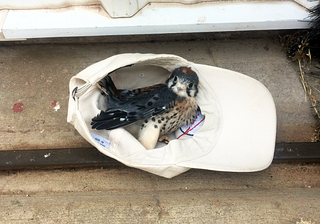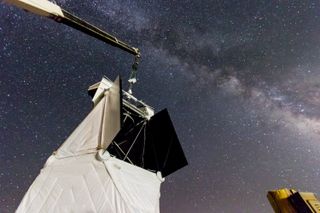Confused Baby Falcon Rescued from Inside Balloon Telescope

When lofting a huge telescope under a giant balloon, you have to prepare for the unexpected. On Friday (June 9) in Fort Sumner, New Mexico, the unexpected arrived in the form of a very confused and unhappy baby falcon.
The falcon entered the hangar where scientists are preparing for the September launch of Fireball-2, a large ultraviolet telescope that hangs from a giant balloon. (Fireball stands for "Faint Intergalactic Redshifted Experiment Balloon," a joint project of NASA, the Jet Propulsion Laboratory, Columbia University, Caltech and the French Laboratoire d'Astrophysique de Marseille.) The falcon landed inside the telescope itself but didn't damage the instrument, according to astronomer Erika Hamden.
"There had been bird noises coming from one of the big bay doors of the hangar for about a week, but we just figured there was probably a nest somewhere up there," Hamden, who works on detectors that Fireball-2 will use to study low-density gas in space, told Live Science. "Yesterday, we opened the doors. I don't know why … and all of a sudden, this little baby bird flew in."
Hamden said the falcon landed inside the open body of the telescope itself, on a relatively sturdy structure that houses the spectrograph. That instrument measures and records the light entering through Fireball-2's big glass eye. [World's Cutest Baby Wild Animals]
"It flapped its wings and cawed a bunch of times like it was really mad," but fortunately didn't do anything to damage the telescope, Hamden said.
The researchers worried that the bird would scratch one of Fireball-2's sensistive lenses or mirrors with its sharp talons and feathers, but fortunately it landed on a structural element of the otherwise-sturdy device.
"[Telescopes like this] have to go up into the stratosphere and then crash-land, so they do try to make them fairly robust," Hamden said.
Sign up for the Live Science daily newsletter now
Get the world’s most fascinating discoveries delivered straight to your inbox.
The researchers on site managed to extract the young bird from the telescope. It wasn't ready to fly away, so Hamden speculated that it was only just learning how to get around using its wings. One of the researchers identified the bird as a juvenile American kestrel.
Cradling the creature in a baseball cap, the researchers moved it outside the hangar and into a shady patch of an open field near the telescope. They replaced the cap with a box, gave the bird a lab dish full of water and made it a bed from the softest thing they had on hand: sterile wipes NASA uses for cleaning telescopes.
After a little while, worried that the bird was positioned too close to people, the researchers moved the box farther into the field.
"The whole time, he was screeching at us," Hamden said.
Hours later, Hamden went to check on the bird and found that it was still there.
"He was standing up and looking annoyed, but when I went back again 30 minutes later, he had disappeared," Hamden said.
Whatever the falcon thought of its encounter with the big, high-flying telescope, the Fireball-2 team has chosen to interpret the avian visit as a "good omen."
In September, the 18-foot-tall (5.5 meters), 3,000-lb. (1,360 kilograms) device will rise above the New Mexico desert, dangling from a 40 million-cubic-foot (1.1 million cubic meters) balloon.

NASA uses its network of balloon telescopes all over the world to peer through the upper stratosphere and test out new instruments.
By the time Fireball-2 launches, according to the Encyclopedia of Life, the young kestrel that invaded the telescope should have long since reached its adult size and weight. Hamden said she saw the bird once more, already flying ably around the airport, before she left town Saturday.
Editor's note: This story was updated on June 14 to correct an error. American kestrels, though sometimes refered to as sparrowhawks, are in fact not hawks but falcons. Thanks to ornithology curator Brian Smith of the American Museum of Natural History for setting us straight. Live Science regrets the error.
Originally published on Live Science.

Most Popular

